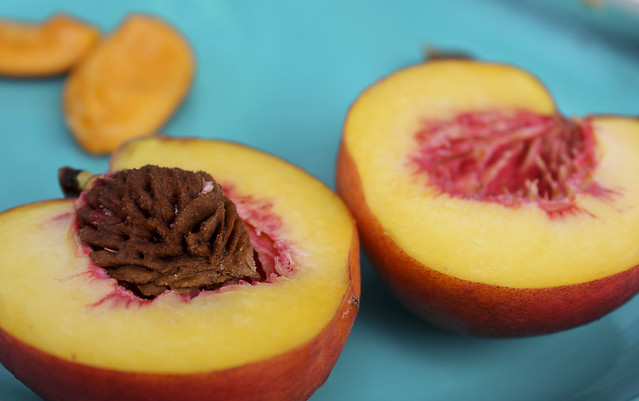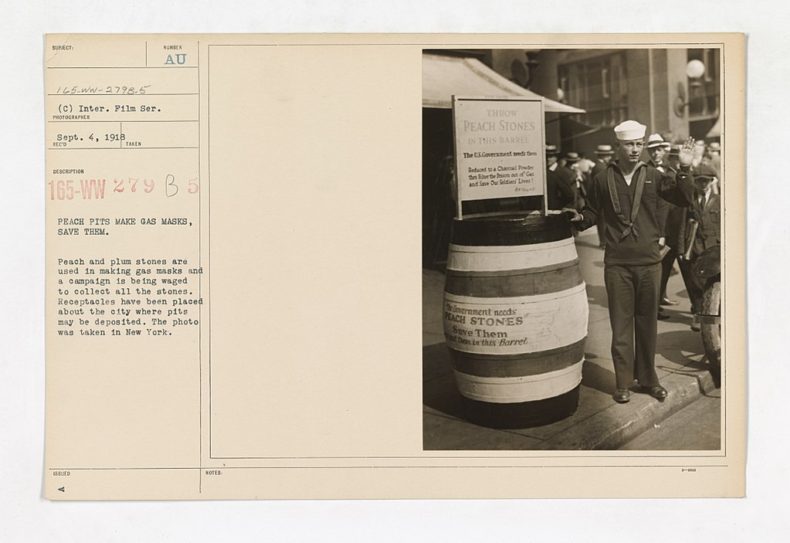
So, you might have read this post before. But have you ever read it while listening to Jack Black sing “Peaches“? Bonus points if you are eating a peach at the same time!
*
Confession time: I used to be a peach hater. What was wrong with me? It’s a question I often find myself asking, too.
Part of it was the pit. When I first saw a peach cut open, I was a kid. It was summer, and I was at a swimming pool. The pit looked like a tiny withered brain. A brain that left bloody marks on the peach flesh all around it, a brain that came out smeared with yellow slime.
A friend told me that the pit was poisonous. In my mind, the poison infused the whole peach, becoming a deadly pink-yellow time bomb, my own forbidden fruit. (It’s true that a peach pit contains amygdalin, which turns into hydrogen cyanide once you eat the pit—so don’t eat peach pits!—but you’d likely have to eat a lot of them to have real problems. This woman ate as many as 40 apricot pits and survived.)
I’m not sure that I ever tasted that swimming pool peach. The peaches that I had tried came from cans. They were orangish, slimy, far too sweet. Much later, I also tried Boone’s Farm Fuzzy Navel, which seemed pleasant enough at the moment, less so the next morning. Swimming was involved again, this time off a houseboat into the Delta. And so, once again, queasiness and peaches were linked, this time without the pit.
My dislike of peaches even extended to imaginary ones. I loved all of Roald Dahl’s books—Charlie and the Chocolate Factory, Matilda, Danny, the Champion of the World – except for one. How creepy it would be, I thought, to travel in a giant peach? (Our very own Rebecca Boyle wrote about a study that found that this massive fruit would actually have needed 2,425,907 seagulls to tote it across the Atlantic.)
Luckily, peaches aren’t that big. But they are fuzzy. What were you supposed to do with all that fuzz? Researchers looked closely at the fuzz, called trichomes, and found that these small hairs both keep peaches from drying out and protect against moisture from the outside. The fuzz may also keep insects from landing on the fruits and laying their eggs on the surface. It did not seem to help protect the giant peach from the assorted giant insects that James finds inside it.

Then last summer we got a few peaches in a farm box. I set them out on the table, looking suspiciously. “Oh, I love peaches!” said one little voice. “I love peaches too!” said another. “Me too!” Who were these children? I thought I’d protected them from the important things—scary movies, clowns, the scarier news–but it turned out that peaches had slipped through the cracks.
But they wanted to eat something! That I actually had! This was unusual. So, I cut into a peach.
The pit didn’t seem too scary this time, and fell right out of the fruit. I’ve since learned that peaches can be freestone or clingstone—or the in-between semi-freestone. There’s much less goop on the freestone peach pits, although I’ve heard the clingstone peaches might be smaller and sweeter.
The kids ate it up and wanted more, so I cut up another peach. And of course, whenever I’m making something for them, I always eat a little bit. I wasn’t testing it for poison, I’m usually just hungry. I didn’t die, and it wasn’t even that fuzzy.
Now, you wouldn’t recognize me. I was at the produce store on Friday, talking to the woman at the register about the difference between the organic local yellow peaches and the pesticide-free Zee Lady peaches. The Zee Ladies are more complicated, she says, and they’re her favorite. I am back again on Sunday, buying more Zee Ladies.
Last summer I even made a peach pie. It was good—after all, you can’t do too much wrong with butter, sugar, and flour. But it seemed like it was missing something. It didn’t taste much like a real peach does, which doesn’t need sugar or butter to be delicious. The pie didn’t have something essential at its center, like a peach does—the pit, the stone, the brains of the peach, doing its genius work of holding everything it needs to grow another tree.
*
Image by Flickr user Sarah under Creative Commons license, 7/28/19
Should you ever find yourself in Western Colorado, say Grand Junction or Fruita for example, it is a magical climate for stone fruits. You can get all the usual varieties, but there are still old orchards there that have earlier types of apricots and peaches, plums and cherries. I’m told that a couple of those places quietly supply the British Royal Family and so forth, which I cannot verify. I can verify that I get that fruit sent to me when it is ripe, in these foam boxes that I send back, and for just a couple of days the whole house smells of summer and joy (and a bit of dog, but that’s baseline).